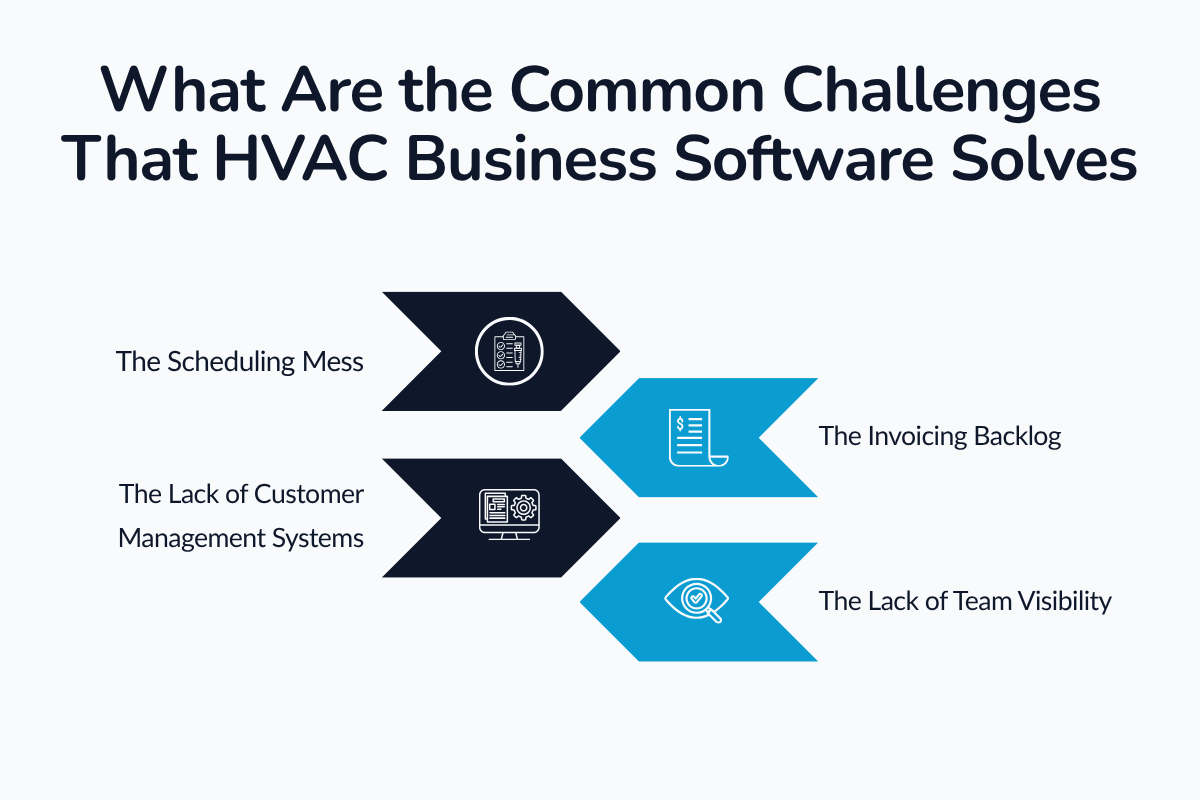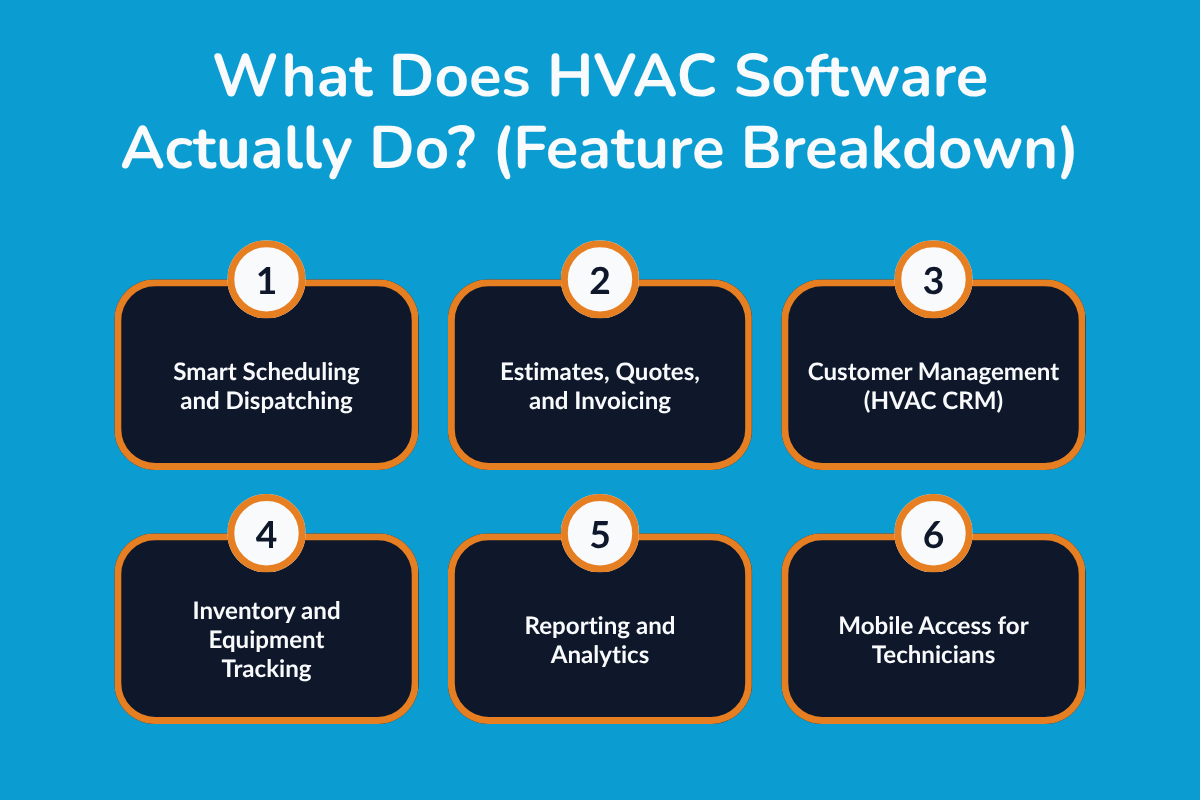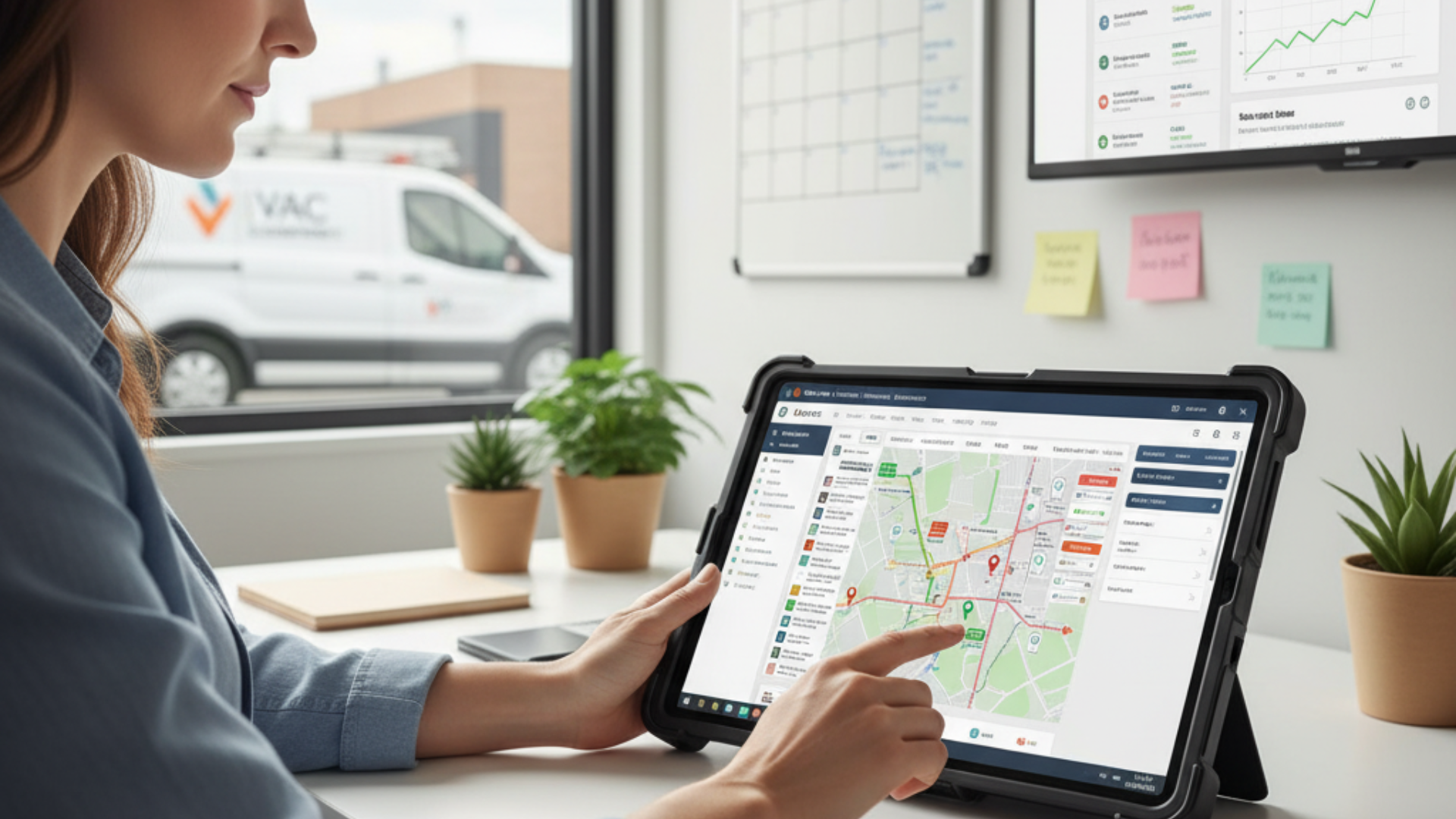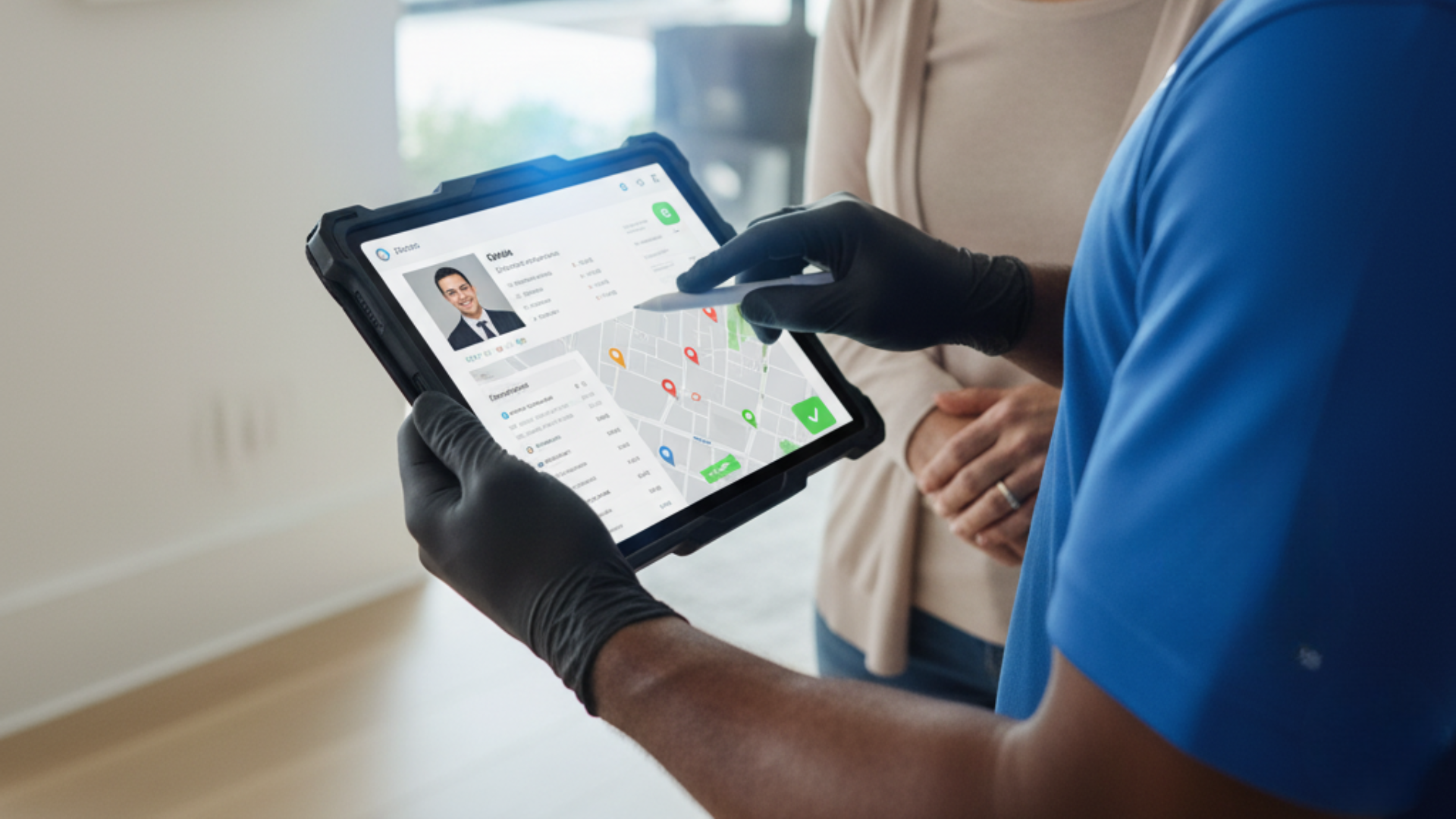What Is HVAC Software A Complete Beginner’s Guide
Did you know that nearly 70% of HVAC businesses still depend on sticky notes, spreadsheets, and manual data entry to track their service calls? In an industry where every minute matters, that’s not just inefficient, it’s costly.
That’s where HVAC software steps in. It’s like the digital backbone of your business, connecting HVAC contractors, technicians, and office teams under one system.
It lets you run your entire HVAC operation from scheduling, invoicing, and customer management to inventory tracking, project management, and GPS tracking, all from a single dashboard.
With built-in payment processing, QuickBooks integration, and mobile apps for technicians in the field, the best HVAC business software transforms everyday service calls into moments of prompt service, seamless communication, and long-term customer loyalty.
Smarter HVAC Software for Businesses: Streamline Service Calls and Management
For today’s HVAC companies, efficiency isn’t optional; it’s survival. Between tight deadlines, skilled labor shortages, and demanding customers, there’s little room for error. That’s why top-performing HVAC businesses utilize advanced HVAC business software, a tool that unifies job scheduling, invoicing, and customer management in a single, connected ecosystem.
With GPS tracking, you can optimize technician routes; with various integrations, you minimize job costing errors; and with mobile access, you stay in sync with every job detail in real time. And what do you get in return? Faster service calls, happier customers, and smarter, data-driven decisions that make your business not just more productive, but more profitable.
Key Takeaways
- HVAC software replaces manual chaos like spreadsheets, whiteboards, and sticky notes—with a single, connected system that automates daily operations.
- It streamlines scheduling, dispatching, invoicing, and customer management, helping businesses save time and reduce human error.
- Mobile apps and GPS tracking improve field technician productivity by delivering real-time job details, routes, updates, and communication.
- A centralized HVAC CRM boosts customer satisfaction and retention through organized records, service reminders, and faster follow-ups.
- QuickBooks and payment integrations eliminate billing delays, improve cash flow, and reduce admin workload.
- Data-driven reporting helps business owners make smarter decisions, forecast demand, and increase profitability.
Ready to modernize your HVAC operations?
See how HVACBase helps you schedule faster, boost technician efficiency, and deliver 5-star service—effortlessly.
What Is HVAC Software? (And Why You’ve Probably Needed It for a While)
HVAC software is an indispensable tool for heating, ventilation, and air conditioning professionals, streamlining operations including scheduling, customer management, invoicing, and equipment maintenance.
It is a digital command center for HVAC contractors and technicians. It helps you manage jobs, customers, and field teams in real time.
From scheduling and invoicing to inventory management and customer relationship management, it handles the details so you can focus on delivering exceptional service.
HVAC business management software keeps your team organized and ensures every service call runs smoothly, without sticky notes, lost messages, or missed deadlines. Think of it as your smart business partner that’s available anytime, anywhere.
How It Works in Real Life for HVAC Companies
Let’s say a customer calls about a heating issue on a freezing morning. Instead of scrambling between spreadsheets and phone calls, you open your HVAC business software.
- The system instantly creates a service call and assigns it to the nearest HVAC technician using GPS tracking.
- The tech receives the job details, customer address, and past service records via the HVAC mobile app.
- While the technician is driving to the job site, the customer automatically receives a confirmation text.
- On-site, the tech checks part availability through inventory management, logs updates, and takes before-and-after photos, all from their phone.
- Once done, the HVAC invoicing software sends a branded digital invoice, processes the payment, and syncs everything with QuickBooks.
Meanwhile, your HVAC CRM stores every interaction, making future service agreements, follow-ups, and customer communication effortless.
That’s the power of automation. You save hours, your team works smarter, and your customers experience reliable, prompt service every single time.
Check out HVAC Project Management 101: Tools, Tips, and Software
What Are the Common Challenges That HVAC Business Software Solves

Running an HVAC business is like balancing multiple systems simultaneously: jobs, customers, technicians, invoices, and parts. Even the most experienced HVAC professionals struggle to juggle everything.
That’s where HVAC service software steps in; it replaces confusion with control. Let’s unpack the everyday challenges it solves.
1. The Scheduling Mess
If you’ve ever double-booked a service call or sent two techs to the same location, you know the frustration. Traditional scheduling tools, whiteboards, and spreadsheets simply can’t keep up.
HVAC scheduling software changes that. It allows you to view every technician’s schedule in real-time and utilizes route optimization to assign jobs based on skill, availability, and location.
For instance, if a technician wraps up early near another job site, the system automatically reassigns them to a nearby residential job or emergency repair. The result? Fewer delays, happier customers, and less wasted time.
2. The Invoicing Backlog
Late invoices and manual billing don’t just slow down payments; they hurt your cash flow. With HVAC invoicing software, billing becomes automatic. Once the job is complete, an invoice is generated instantly, with your company branding and payment processing links.
It even syncs with accounting software like QuickBooks, ensuring accurate records without extra work. Think of it as your built-in accountant, saving time and getting you paid faster.
3. The Client Chaos and Lack of Customer Management
When customer information lives in scattered texts and notebooks, it’s easy to lose track of service agreements or repair history. HVAC CRM tools centralize all customer data, including job history, equipment notes, and preferences such as “morning visits only.”
So when HVAC techs visit Mrs. Smith next time, they will know exactly what system she owns, what was fixed last time, and how to offer exceptional service without needing to ask twice.
This not only improves customer satisfaction but also builds long-term customer loyalty through personalized care.
4. The Lack of Team Visibility
Without live updates, field managers are left guessing. Are the techs on-site? Is the job done? Are we running behind schedule?
With HVAC field service software, every technician's route and job updates appear in real-time. Managers can track progress, reassign jobs, or alert teams to new emergency repairs instantly. It facilitates seamless communication, enhances operational efficiency, and enables businesses to maximize efficiency across every project.
In short, HVAC management software transforms daily headaches into streamlined workflows. It helps HVAC business owners reduce chaos, strengthen customer relationships, and deliver prompt, professional service every time.
The difference is simple: fewer mistakes, faster jobs, and customers who actually enjoy doing business with you.
What Does HVAC Software Actually Do? (Feature Breakdown)

Modern HVAC software isn’t just a digital planner; it’s the backbone of efficient HVAC businesses. Right from scheduling service calls to tracking inventory and managing customers, it streamlines every moving part of your operations. Let’s break down what it actually does (and why it matters).
1. Smart Scheduling and Dispatching
Have you ever faced a double-booked technician or a lost route? HVAC management software addresses this issue with real-time calendars, advanced scheduling, and GPS-based route optimization.
Dispatchers can assign the nearest available HVAC tech, reduce travel time, and handle emergency calls without chaos. According to a 2022 McKinsey & Company report, companies that utilize AI-based route optimization tools have reduced delivery times by up to 20%.
2. Estimates, Quotes, and Invoicing
No more chasing payments or juggling Excel sheets. With HVAC invoicing software, technicians can send professional proposals, convert them into quotes, and generate invoices automatically after job completion.
Integration with QuickBooks or other accounting software ensures that every payment and expense is synced, speeding up cash flow and reducing manual data entry.
3. Customer Management (HVAC CRM)
Scattered client notes become one organized hub. An HVAC CRM stores customer details, job history, and service agreements, allowing personalized communication and automated maintenance reminders.
For residential HVAC businesses, this means stronger relationships; for commercial clients, it means consistent, data-backed reporting.
4. Inventory and Equipment Tracking
Running out of parts mid-job is every contractor’s nightmare. HVAC field service software includes inventory management to track material usage, alert teams when stock levels are low, and link usage directly to job costing, ensuring seamless project management and fewer job delays.
5. Reporting and Analytics
With robust reporting tools, owners can finally see what’s working. Track revenue, technician efficiency, job turnaround time, and company performance at a glance.
Data-driven insights enable the forecasting of demand, enhance profitability, and optimize efficiency.
6. Mobile Access for Technicians
The HVAC mobile app keeps every HVAC technician connected on-site. They can view schedules, update job details, capture photos, and process payments, all from their mobile device.
This field service management capability eliminates communication gaps and ensures prompt service, even during emergency repairs.
Together, these features make the best HVAC software more than a management tool; it’s your all-in-one digital command center to streamline operations, boost customer loyalty, and elevate the entire service experience.
Explore The Future of HVAC: IoT, Smart Thermostats and More.
The Real-World Impact: Before and After HVAC Software
Adopting a new digital tool can feel daunting, but the difference between running your HVAC service on spreadsheets versus dedicated HVAC software is like night and day. It’s less about adding a new tool and more about removing old frustrations.
> Before Software: The "Organized" Chaos
Let's face it: the "old way" is familiar but incredibly inefficient. The office whiteboard is covered in scribbles, arrows, and erased smudges.
A customer calls with an emergency repair, and the office manager yells across the room, "Who's closest to downtown?"
Your HVAC technicians are calling in for job details and customer information, such as their address or past service history, which is often buried in a text message, an old email, or a sticky note that fell off the desk.
At the end of the day, techs return with a pile of paper invoices that need manual data entry, making job costing a guessing game and delaying your cash flow by weeks.
> After Software: Calm, Connected Control
Now, picture this: That same emergency call comes in. You instantly pull up the client's complete file in your HVAC CRM.
With a single click, your HVAC scheduling tool identifies the nearest tech using GPS tracking and sends the entire work order, including customer details and service agreements, directly to their HVAC mobile app.
The customer automatically receives a text message: "Your technician, Dave, is on the way." The tech completes the job, processes the payment on-site, and the invoice is automatically synced with your accounting software. The entire process is closed out before Dave even leaves the driveway.
> Bonus: Improved Customer Retention
This efficiency isn't just for you; it’s a powerful tool for customer satisfaction. When you offer prompt service, provide accurate arrival times, and send digital invoices, you create a seamless, professional customer experience.
That positive experience is what builds customer loyalty, turning a one-time fix for commercial clients or residential jobs into a profitable, long-term maintenance contract.
Here’s a quick comparison of the difference management software makes:
| Task | Before Software (The Old Way) | After Software (The Smart Way) |
|---|---|---|
| Scheduling | A chaotic whiteboard, double bookings, and frantic phone calls. | Drag-and-drop digital calendar, optimized routes. |
| Dispatching | Guessing tech locations, manually relaying job details. | GPS tracking locates the nearest technician; instant job dispatch to their mobile device. |
| Client Info | Lost in notebooks, texts, or spreadsheets. | Centralized HVAC CRM with full job history and equipment details. |
| Invoicing | Manual data entry, paper invoices, and delayed payments. | Instant digital invoices, on-site payment processing, QuickBooks sync. |
| Visibility | No idea where techs are or a job's status. | Real-time company performance dashboards and job progress tracking. |
Types of HVAC Software (And Which One You Might Need)
The "Best HVAC Software" is simply the one that fits your company's specific needs. The HVAC industry is diverse, and the software solutions reflect that. Here’s a basic breakdown of the main categories.
1. All-in-One HVAC Management Platforms
These are complete field service management software packages like HVACBase. They are designed for HVAC businesses that want to manage their entire operation from one platform.
This typically includes customer management tools (CRM), advanced scheduling and dispatching, HVAC invoicing software, inventory management, and often lead management. They connect every part of your HVAC operations, from the first call to the final report.
2. HVAC Dispatching or Scheduling Tools
If you're a smaller residential HVAC business or your main bottleneck is just getting techs to the right job site efficiently, a standalone scheduling tool might be perfect.
These platforms focus heavily on smart calendars, job scheduling, and optimizing technician routes to maximize efficiency and reduce fuel costs.
3. HVAC Estimating and Quoting Tools
For HVAC contractors who focus heavily on construction jobs, replacements, or new installations, the most critical step is the bid.
HVAC estimating software is built to help you create detailed, accurate, and professional proposals quickly. They often include digital price books and good/better/best options to help you win more bids.
4. Field Service Management (FSM) Suites
While similar to "All-in-One" platforms, FSM suites are often designed for mid-sized to larger firms that manage multiple crews, multiple service types (such as plumbing or electrical), or complex commercial clients.
They have robust reporting tools and features for handling complex project management, tracking inventory across many vehicles, and managing multi-layer service agreements.
Best HVAC Software in 2025: Quick Comparison

Remember, the "best" software is the one your team will actually use, so always take advantage of a demo to see the benefits of HVAC software for yourself.
1. HVACBase
- About: HVACBase is a modern, all-in-one HVAC business software designed to streamline operations for contractors. It combines powerful field service management tools with a simple, intuitive interface, enabling HVAC businesses to manage their entire operations from a single platform.
- Ideal Business Size: It is ideal for small to mid-sized residential HVAC businesses and larger, commercial businesses looking for a scalable solution without unnecessary complexity.
- Key Features: Smart HVAC scheduling, a powerful HVAC CRM for customer management, one-click HVAC invoicing software, robust inventory management, and a simple-to-use HVAC mobile app for technicians.
- Ease of Use: Built to be intuitive from day one. The clean dashboard and mobile-first design require minimal training for your office staff and HVAC technicians.
- Pricing: Offers flexible, transparent plans designed to grow with your business. (Contact for a demo and custom quote).
2. FieldEdge
- About: A long-standing and robust field service software, FieldEdge is for established contractors in HVAC, plumbing, and electrical. It's known for its deep integration capabilities and strong feature set for managing service agreements.
- Ideal Business Size: Mid-sized to large residential service businesses that need powerful, detailed features and have dedicated office staff.
- Key Features: Deep QuickBooks integration (desktop and online), a very detailed flat-rate price book, "good-better-best" professional proposals, and comprehensive service agreement management.
- Ease of Use: Can have a steeper learning curve due to its extensive features. Some users find the interface less modern, but it's very powerful once learned.
- Pricing: Quote-based. It is generally considered a premium-priced solution, often billed per user, per month, and may include a setup fee. They include a Select, Premier, and Elite option.
3. ServiceTitan
- About: ServiceTitan is an enterprise-level, all-in-one management software that is a dominant player in the HVAC industry. It's built to manage every aspect of a large home service business, from call booking and marketing to dispatch and robust reporting tools.
- Ideal Business Size: Large, established residential and commercial HVAC companies that need a single, powerful system to manage complex HVAC operations.
- Key Features: Advanced reporting and KPI dashboards, AI-powered dispatching, integrated marketing (call tracking, email campaigns), and built-in customer financing options.
- Ease of Use: Extremely powerful but known for its complexity. Expect a significant onboarding and training process to leverage its full capabilities.
- Pricing: Quote-based. This is a premium-priced solution, often cited as one of the most expensive options, with a per-technician monthly fee. They offer Starter, Essentials, and The Works packages.
4. Jobber
- About: Jobber is a highly popular and user-friendly HVAC management software that excels at customer relationship management and workflow simplicity. It's designed to help small businesses look professional and maximize efficiency.
- Ideal Business Size: Small to mid-sized residential HVAC businesses, especially owner-operators or those scaling their team for the first time.
- Key Features: Excellent "client hub" (a self-service online portal for customers), automated customer communication (reminders, follow-ups), two-way texting, online booking, and easy quoting.
- Ease of Use: Consistently rated as one of the most user-friendly and intuitive platforms. Its clean interface and great HVAC mobile app make adoption easy.
- Pricing: Transparent, tiered pricing core plan: $29-$39/month, connect plan for teams: $129/month (billed annually), grow plan for teams $249/month(billed annually), plus for teams $449/month (billed annually).
5. Housecall Pro
- About: A mobile-first platform designed to help home service professionals manage their business operations entirely from their mobile devices. It's particularly strong in terms of technician-in-the-field experience.
- Ideal Business Size: Owner-operators and small residential HVAC businesses who prioritize simplicity and mobile functionality.
- Key Features: Simple drag-and-drop job scheduling, on-site payment processing, online booking, community forums, and simple marketing tools (like automated postcard mailers and review requests).
- Ease of Use: Very easy to learn and use, especially the mobile app. Please note that some key features, such as QuickBooks integration and GPS tracking, are only available in their higher-priced plans.
- Pricing: Offers tiered, public pricing- basic (1 user): $59/mo-$79/mo, essentials (up to 5 users): $149-$189/mo, max (custom quote, 8 users): $299+/mo- $329/mo. Add-ons: $80/month recurring plans, $20/month/vehicle GPS.
Here's HVAC Scheduling and Dispatch Programs: Top Picks.
How to Choose the Right HVAC Software for Your Business
Finding the best HVAC software for your HVAC business isn't about buying the platform with the most features; it's about finding the one that solves your specific problems.
- First, prioritize ease of use. If the HVAC mobile app is clunky and slow, your technicians in the field simply won't use it, and you'll lose the primary benefit. Look for a clean interface and a simple workflow for job details.
- Next, check integrations. Your HVAC business management software must talk to your other tools. A seamless QuickBooks integration is non-negotiable for most, as it eliminates hours of manual data entry and streamlines payment processing.
- Also, think about your future. Most modern software solutions are cloud-based, meaning they are easier to scale, update, and access from anywhere on mobile devices. An older on-premise system might feel secure, but it's often more expensive and harder to adapt as you add more techs.
- Finally, compare before you commit. Never buy a platform based solely on a sales pitch. Sign up for every demo and trial. Run your most common service calls through the system, from scheduling and estimating to final invoicing, to see how it really works.
The ROI of HVAC Software: Does It Really Pay Off?
Let's talk numbers. The initial cost of HVAC management software can cause hesitation, but the return on investment (ROI) is one of the fastest in the industry. The biggest gain? Turning wasted time into billable time.
Smart management software, such as HVACBase, directly addresses inefficiencies. LogiNext states that route optimization alone can cut fuel costs and drive time by 30%. That saved time allows smart scheduling tools to help each tech complete an average of one to two more residential jobs per day. That's pure profit.
The "real savings" are just as significant. Invoicing software reduces manual data entry, a task that can consume 60% or more of an admin's day, and helps you get paid faster. You'll stop losing money from missed service agreements, inaccurate job costing, or lost customer information.
How do you measure success after making a purchase? Track your key metrics: Look for a jump in your first-time fix rate, a higher number of completed service calls per technician, and a drop in the time between job completion and payment.
Conclusion: The Future of HVAC Is Digital
The HVAC industry is evolving, and relying on paper and whiteboards is no longer a sustainable option.
Software isn’t here to replace the expertise of contractors; it’s here to empower them.
By automating time-consuming tasks such as scheduling, invoicing, and customer management, these digital tools enable you to focus on what truly matters: delivering exceptional service and growing your business profitably.
About HVACBase
HVACBase is a modern, all-in-one HVAC business software designed to help contractors streamline their entire operations, from scheduling and invoicing to customer management.
Schedule a demo today! And see HVACBase in action.
FAQs
Which is the best software for HVAC?
The "best" software depends on your size. HVACBase offers a modern, all-in-one solution, while ServiceTitan is popular among large companies, and Jobber is ideal for small businesses.
What is the $5000 rule for HVAC?
It's a guideline: if the repair cost multiplied by the unit's age (in years) exceeds $5,000, replacement is generally recommended.
Can HVAC make $100,000 a year?
Yes, experienced technicians, especially those in unions or with sales skills, as well as most successful business owners, can earn over $100,000.
How much does HVAC software cost?
Costs vary widely, ranging from $40 to $150 per month for simple plans to over $300 per user per month for advanced enterprise platforms.
Have questions or need personalized advice?
Talk to an Expert Today and let our construction specialists guide you to success.






